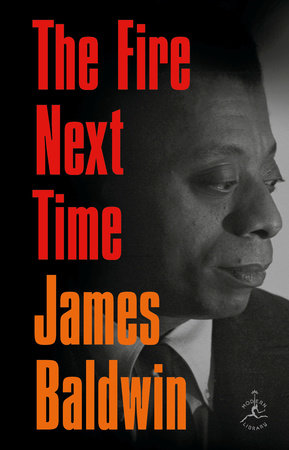The Fire Next Time Reader’s Guide
By James Baldwin


1. In The Fire Next Time, Baldwin moves seamlessly between piercing social commentary and deeply reflective personal narrative. Why do you think Baldwin chose to combine the genres of essay and biography? How did doing so impact your understanding of his argument as well as your overall reading experience?
2. The Fire Next Time is deeply intergenerational, addressing three generations of Baldwin’s family and pulling from centuries of Black history. Why does Baldwin emphasize the importance of knowing your history and where you come from? What role does the Black past play in shaping the future that he is working toward?
3. Baldwin writes “My Dungeon Shook: Letter to My Nephew on the One Hundredth Anniversary of the Emancipation” to his fifteen-year-old namesake, who is coming of age during the civil rights movement. Why would this letter be important to a Black child of this age at this time? What advice does Baldwin give to his nephew for navigating the country he’s inherited?
4. While “My Dungeon Shook” is written to Baldwin’s fifteen-year-old nephew, “Down at the Cross: Letter from a Region in My Mind” follows Baldwin from the age of fourteen onward. What is the relationship between the two letters? How are themes that were introduced in the first letter further illuminated in the second?
5. Why do you think Baldwin chose to write both essays as letters? While “Down at the Cross” doesn’t say who it’s addressed to, only where it’s from, who do you think the audience is?
6. In “Down at the Cross,” Baldwin returns to the image of the wine-and-urine-stained hallways of his youth. What does this image initially represent for him, and how does his perception of it change in the essay’s closing?
7. On page 26, Baldwin explains how Black children are conditioned from a young age to adhere to white authority. What role do parents play in this process, and what forces shape their actions? Is this ultimately harmful or protective? How did Baldwin react the summer he turned fourteen?
8. How does Baldwin view the relationship between the struggle of Black Americans and Christianity? What factors ultimately led to his disillusionment with the church?
9. Following his early years as a youth minister, Baldwin becomes critical of the church and skeptical of all religions that try to provide solutions to the struggle of Black Americans. What values take the place of organized religion in Baldwin’s life? How would you describe his morals, and how do you think they worked to advance his activism?
10. Despite his skepticism, Baldwin acknowledges the achievements of the Nation of Islam in addressing central issues faced by the Black community and asks how they were accomplished. What circumstances does he believe led to the Nation of Islam becoming a significant voice in the Black community?
11. Baldwin uses his meeting with the Honorable Elijah Muhammad and the Nation of Islam to introduce the rhetoric of the Black Power movement, including calls for nation-building and economic reparations, the embrace of the African past, and slogans of racial pride including “Black is beautiful.” What is Baldwin’s response to Black nationalism, and how does his vision of the future of the United States differ from those proposed by the Nation?
12. Why does Baldwin assert that self-definition is essential to navigating the world as Black people?
13. Baldwin pulls from the Black vernacular tradition by incorporating hymns, spirituals, and sermons in The Fire Next Time. What does this tradition add to the text, and how does it work to answer the question posed on page 103: “How can the American Negro past be used?”
14. The Fire Next Time is one of a growing list of books being banned in schools across America. How does this fact emphasize the challenge that Baldwin believes stands in the way of fully celebrating Black achievement in America?
15. The epigraphs to “Down at the Cross” quote Rudyard Kipling’s 1899 poem “The White Man’s Burden” and E. A. Hoffman’s 1878 hymn “Down at the Cross.” Consider reading the full-text versions of each. How does each author engage with Christian theology? Why do you think Baldwin chose to write in conversation with both texts?
16. How did you react to Baldwin’s final warning, “God gave Noah the rainbow sign, No more water, the fire next time!” (page 106)?
17. In 1963, Baldwin wrote, “You know, and I know, that the country is celebrating one hundred years of freedom one hundred years too soon” (page 10). More than sixty years later, how does this text continue to speak to the state of Black life and race relations in America? Has the country accomplished emancipation yet?